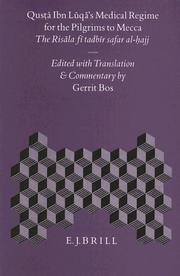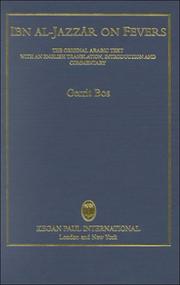| Listing 1 - 10 of 66 | << page >> |
Sort by
|

ISSN: 01698729 ISBN: 9004095411 9004451153 9789004095410 9789004451155 Year: 1992 Volume: 11 Publisher: Leiden Brill
Abstract | Keywords | Export | Availability | Bookmark
 Loading...
Loading...Choose an application
- Reference Manager
- EndNote
- RefWorks (Direct export to RefWorks)
This work by Qusṭā Ibn Lūqā, the only known health guide for the pilgrim to Mecca, discusses in a concise and logical manner the best regime for the traveller, the diseases which may befall him and their treatment. It is an eloquent witness to the author's profound knowledge of the works of ancient physicians, especially those of the Byzantine physician Paul of Aegina. After an exposition of the best regimen for the traveller, Qusṭā mentions the different diseases which may befall him, namely, fatigue, earache, diseases of the bronchial tubes and those caused by dust. Recommended remedies are simple and compound drugs, bathing and massage. Qusṭā then discusses criteria to determine the quality of water, means to improve bad water, and means to quench one's thirst. In the next chapters Qusṭā treats the prophylaxis against vermin and the treatment of stings and bites caused by them. After a lucid exposition of spontaneous generation, Qusṭā concludes his treatise by discussing the occurrence of the Dracunculus medinensis and its treatment.
Arab medicine --- Geneeskunde [Arabische ] --- Medecine arabe --- Medicine [Arab ] --- Medicine [Arabic ] --- Medicine, Arab. --- Travel --- Muslim pilgrims and pilgrimages --- Health aspects --- Handbooks, manuals, etc. --- Early works to 1800 --- Mecca (Saudi Arabia) --- Medicine, Arabic. --- Travel - Health aspects - Handbooks, manuals, etc. - Early works to 1800. --- Muslim pilgrims and pilgrimages - Health aspects - Saudi Arabia - Mecca - Early works to 1800. --- Medicine, Arab --- Traveling --- Travelling --- Islamic pilgrims and pilgrimages --- Pilgrims and pilgrimages, Muslim --- Medicine, Arabic --- Medicine, Unani --- Tibb (Medicine) --- Unani medicine --- Unani-Tibb (Medicine) --- Health aspects&delete& --- Handbooks, manuals, etc --- Tourism --- Voyages and travels --- Medicine, Medieval --- Muslim travelers --- Pilgrims and pilgrimages

ISBN: 1315029960 1136884866 0710305702 1138972185 Year: 2011 Publisher: London, [England] ; New York : Routledge,
Abstract | Keywords | Export | Availability | Bookmark
 Loading...
Loading...Choose an application
- Reference Manager
- EndNote
- RefWorks (Direct export to RefWorks)
First published in 2000. Routledge is an imprint of Taylor & Francis, an informa company.
Fever --- Medicine, Arab. --- Medicine, Medieval. --- Ibn al-Jazzār. --- Medicine, Medieval --- Medieval medicine --- Arab medicine --- Medicine, Arab --- Medicine, Arabic --- Medicine, Unani --- Tibb (Medicine) --- Unani medicine --- Unani-Tibb (Medicine) --- Ibn al-Ǧazzār --- Aḥmad ibn Ibrāhīm al-Jazzār --- Jazzār, Aḥmad ibn Ibrāhīm --- Ibn al-Jazzār, Abū Jaʻfar Aḥmad ibn Ibrāhīm --- Abū Jaʻfar Aḥmad ibn Ibrāhīm al-Jazzār --- Ibn al-Jazzār al-Qayrawānī, Aḥmad ibn Ibrāhīm --- Qayrawānī, Aḥmad ibn Ibrāhīm --- ابن الجزار --- أحمد بن إبراهيم الجزار --- جزار، أحمد بن إبراهيم --- ابن الجزار، أبو جعفر أحمد بن إبراهيم --- أبو جعفر أحمد بن إبراهيم الجزار --- ابن الجزار القيرواني، أحمد بن إبراهيم --- قيرواني، أحمد بن إبراهيم --- القيرواني، أحمد بن إبراهيم --- ابن الجزار، أحمد بن إبراهيم --- Ibn al-Jazzār, Aḥmad ibn Ibrāhīm --- Ibn al-Jazzar.
Book
ISBN: 9004288619 9789004288614 9789004288478 9004288473 1322872937 Year: 2015 Publisher: Leiden Brill
Abstract | Keywords | Export | Availability | Bookmark
 Loading...
Loading...Choose an application
- Reference Manager
- EndNote
- RefWorks (Direct export to RefWorks)
The medical compendium entitled Zād al-musāfir wa-qūt al-ḥāḍir ( Provisions for the Traveller and the Nourishment for the Sedentary ) and compiled by Ibn al-Jazzār from Qayrawān in the tenth century is one of the most influential medical handbooks in the history of western medicine. In the eleventh century, Constantine the African translated it into Latin; this translation was the basis for the commentaries by the Salernitan masters from the twelfth century on, and was popular in Jewish circles as well, as is attested by the fact that it was translated into Hebrew three times. The current volume covers Book 7, chapters seven to thirty of Ibn al-Jazzār’s compendium. These chapters cover a wide variety of external afflictions such as measles and smallpox; bites and stings; rabies; tumours; warts and calluses, leprosy, scurf and eczema, pruritus and scabies, furuncles, scrofula, sharā and heat rashes; fractures and dislocations; haemorrhages caused by a sword, knife or arrow; whiteness of the nails and paronychia; burns; wounds caused by pressure from the shoes; and fissures in the hands and feet.
Skin --- Diseases --- Treatment. --- Diagnosis. --- Wounds and injuries --- Communicable diseases --- Medicine, Arab. --- Skin Diseases --- Medicine, Arabic. --- Wounds and Injuries --- Treatment --- therapy. --- Ibn al-Jazzār. --- Ibn al-Jazzār. --- therapy --- Diagnosis
Book
ISBN: 9004428178 900442816X Year: 2020 Publisher: Leiden, The Netherlands ; Boston : Brill,
Abstract | Keywords | Export | Availability | Bookmark
 Loading...
Loading...Choose an application
- Reference Manager
- EndNote
- RefWorks (Direct export to RefWorks)
The original Arabic text of Maimonides’ major medical work, Medical Aphorisms, was critically edited and translated into English by Gerrit Bos in the years 2004-2017, and published in earlier volumes of the book series The Medical Works of Moses Maimonides. The present work is a new critical edition of the medieval Hebrew translation by Nathan ha-Meʾati, who was active as a translator of scientific texts in Rome in the late thirteenth century, where his colleague Zeraḥyah Ḥen had completed a translation of the same Maimonidean text in 1277, only a few years earlier. Nathan aimed to provide the general reader with a translation that was easier to understand than Zeraḥyah's translation. The present critical edition of Nathan’s translation is primarily based on MS Paris, BN, héb. 1174, and not on MS Paris, BN, héb. 1173, used by Suessmann Muntner for his edition in 1959, as this copy suffers from many mistakes and corruptions.
Book
ISBN: 900439866X 9004398651 9789004398665 9789004398658 Year: 2019 Publisher: Leiden
Abstract | Keywords | Export | Availability | Bookmark
 Loading...
Loading...Choose an application
- Reference Manager
- EndNote
- RefWorks (Direct export to RefWorks)
The terminology in medieval Hebrew medical literature (original works and translations) has been sorely neglected by modern research. Medical terminology is virtually missing from the standard dictionaries of the Hebrew language, including Ha-Millon he-ḥadash, composed by Abraham Even-Shoshan. Ben-Yehuda’s dictionary is the only one that contains a significant number of medical terms. Unfortunately, Ben-Yehuda’s use of the medieval medical texts listed in the dictionary’s introduction is inconsistent at best. The only dictionary exclusively devoted to medical terms, both medieval and modern, is that by A.M. Masie, entitled Dictionary of Medicine and Allied Sciences . However, like the dictionary by Ben-Yehuda, it only makes occasional use of the sources registered in the introduction and only rarely differentiates between the various medieval translators. Further, since Masie’s work is alphabetized according to the Latin or English term, it cannot be consulted for Hebrew terms. The Historical Dictionary of the Hebrew Language, which is currently being created by the Academy of the Hebrew Language, has not been taken into account consistently as it is not a dictionary in the proper sense of the word. Moreover, consultation of this resource suggests that it is generally deficient in medieval medical terminology. The Bar Ilan Responsa Project has also been excluded as a source, despite the fact that it contains a larger number of medieval medical terms than the Historical Dictionary . The present dictionary has two major objectives: 1) to map the medical terminology featured in medieval Hebrew medical works, in order to facilitate study of medical terms, especially those terms that do not appear in the existing dictionaries, and terms that are inadequately represented. 2) to identify the medical terminology used by specific authors and translators, to enable the identification of anonymous medical material.
Book
Year: 1935 Publisher: Assen Van Gorcum
Abstract | Keywords | Export | Availability | Bookmark
 Loading...
Loading...Choose an application
- Reference Manager
- EndNote
- RefWorks (Direct export to RefWorks)
Book
Year: 1937 Publisher: Assen Van Gorcum
Abstract | Keywords | Export | Availability | Bookmark
 Loading...
Loading...Choose an application
- Reference Manager
- EndNote
- RefWorks (Direct export to RefWorks)
Book
Year: 1939 Publisher: Assen Van Gorcum
Abstract | Keywords | Export | Availability | Bookmark
 Loading...
Loading...Choose an application
- Reference Manager
- EndNote
- RefWorks (Direct export to RefWorks)
Book
Publisher: Assen Van Gorcum
Abstract | Keywords | Export | Availability | Bookmark
 Loading...
Loading...Choose an application
- Reference Manager
- EndNote
- RefWorks (Direct export to RefWorks)
Book
Publisher: Schiedam Roelants
Abstract | Keywords | Export | Availability | Bookmark
 Loading...
Loading...Choose an application
- Reference Manager
- EndNote
- RefWorks (Direct export to RefWorks)
Theatrical science --- pianoreducties --- opera's (genre) --- anno 1900-1999 --- Netherlands
| Listing 1 - 10 of 66 | << page >> |
Sort by
|

 Search
Search Feedback
Feedback About UniCat
About UniCat  Help
Help News
News